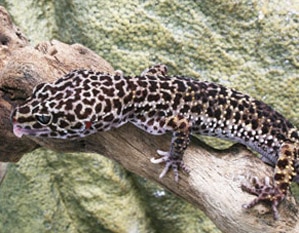The African spurred tortoise (Geochelone sulcata) is at once a highly desirable and problematical pet. One of the most engaging of all tortoises, with long-term pets exhibiting a degree of responsiveness more commonly associated with dogs, hatchlings are available for modest prices.
Size
 Spurred tortoises are, however, the largest of all mainland tortoises, and may attain weights in excess of 200 pounds. Only one other mainland species, the yellow-footed tortoise (G. denticulata), gives the spurred any serious competition. A friend wrote me that he recently examined a 60 year old captive that weighed 190 pounds.
Spurred tortoises are, however, the largest of all mainland tortoises, and may attain weights in excess of 200 pounds. Only one other mainland species, the yellow-footed tortoise (G. denticulata), gives the spurred any serious competition. A friend wrote me that he recently examined a 60 year old captive that weighed 190 pounds.
A harsh natural habitat – the southern fringe of the Sahara Desert – has equipped spurred tortoises with a remarkable ability to grow rapidly when food is plentiful. I weighed 2 individuals that topped 60 pounds by age 5!
Space
Few hobbyists are equipped to properly care for a spurred tortoise. They require a great deal of room, with males being particularly active during the breeding season. Indeed, a ½ acre outdoor exhibit I over-saw proved too small for a pair of 80 pounders.
A determined spurred tortoise is also difficult to confine, and will dig under or plow through seemingly impenetrable barriers. Males may become territorial, and treat people and other pets as threats.
Stopping Traffic in Manhattan
 I took in the tortoise pictured here when its owner could no longer provide for it. He is currently at Social Tees, New York City’s premier animal rescue facility, awaiting transport to a new outdoor home in Florida.
I took in the tortoise pictured here when its owner could no longer provide for it. He is currently at Social Tees, New York City’s premier animal rescue facility, awaiting transport to a new outdoor home in Florida.
It takes some doing to raise eyebrows in Manhattan’s East Village, but as you can see from the photo this stout fellow does so admirably. In fact, Social Tees reptile expert Robert Shapiro has dubbed him “Speed Bump” because of his traffic-stopping abilities! When not meeting new neighbors, “Speed Bump” has the run of a large outdoor yard – not easy to arrange at today’s rents!
Island Giants
The African spurred tortoise is exceeded in size only by 2 island-dwelling species, the Aldabra (G. gigantea) and Galapagos tortoises (G. elephantopus). Those on the Aldabra Islands (between Kenya and Madagascar) are the only survivors of a host of giant species that once inhabited the Seychelles and other islands in the Indian Ocean. Sadly, all were hunted to extinction by the early 1800’s.
Aldabra tortoises exceed the better-known “Galaps” in size. What may be the world’s largest terrestrial turtle was an Aldabra that resided at the London Zoo and is now preserved in the British Museum. This fellow weighed 560 pounds at the time of his death, by which point he had lost weight; he may have topped 600 pounds in his prime.
I have worked with both species, and found them to be unbelievably intelligent…Aldabra tortoises cover their food trays, backing up to expose only a bit of food at a time, so as not to draw the attention of hungry exhibit mates!
Please Plan Ahead
Despite my enthusiasm, I must advise you to think carefully before taking on even a small spurred tortoise. Please think long-term, and write in for advice.
Further Reading
I’ve recounted some interesting giant tortoise stories in the following articles:
Feisty Terrier Proves no Match for African Spurred Tortoise
How Reptiles Adjust to Novel Situations
Legendary turtle biologist Peter Prichard gives a wonderful account of living and extinct giant tortoises in the classic Encyclopedia of Turtles (TFH, 1979).
Please write in with your questions and comments. Thanks, until next time, Frank Indiviglio.
 That Reptile Blog – Reptile, Amphibian and Exotic Pet Care and Information
That Reptile Blog – Reptile, Amphibian and Exotic Pet Care and Information

 Praying mantids vie with weasels and shrews as the most rapacious of all predators…I once saw a female Chinese mantid (Tenodera aridifolia sinensis) catch and consume a hornet while she was copulating! Females of many species eat their mates, often during the act of mating.
Praying mantids vie with weasels and shrews as the most rapacious of all predators…I once saw a female Chinese mantid (Tenodera aridifolia sinensis) catch and consume a hornet while she was copulating! Females of many species eat their mates, often during the act of mating. Leopard, banded and fat-tailed geckos are classified in the gecko subfamily Eublepharinae, and differ from all other geckos in having movable eyelids. In fact, the genus name, Eublepharis, means “true eye lids”. The eyes of all other species in the family Gekkonidae are covered by a transparent cap, or spectacle, which is fused to the eyelids (like snakes, they cannot blink their eyes).
Leopard, banded and fat-tailed geckos are classified in the gecko subfamily Eublepharinae, and differ from all other geckos in having movable eyelids. In fact, the genus name, Eublepharis, means “true eye lids”. The eyes of all other species in the family Gekkonidae are covered by a transparent cap, or spectacle, which is fused to the eyelids (like snakes, they cannot blink their eyes).